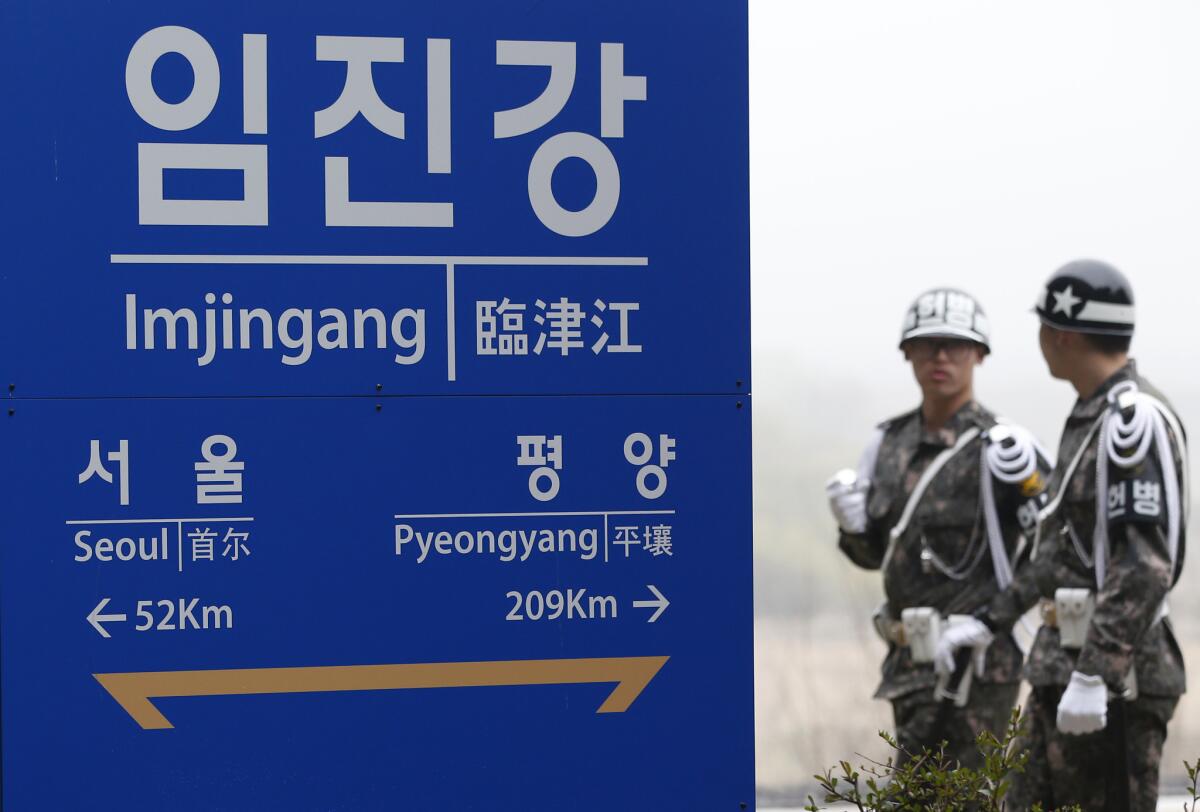North Korea claims successful test of rocket engine capable of reaching U.S.

South Korean soldiers walk by a signboard showing the distance to the North Korea’s capital Pyongyang and to South Korea’s capital Seoul from Imjingang Station near the border village of the Panmunjom in Paju, South Korea on April 9.
- Share via
Reporting from SEOUL — North Korea’s latest belligerent declaration — that it successfully tested a new long-range rocket engine that could allow nuclear strikes on the U.S. mainland — leaves outsiders in a familiar predicament.
With only a few details and no independent confirmation of what happened, there’s the usual skepticism. But if even only part of the long list of nuclear and missile work that the North has boasted of successfully completing since its fourth nuclear test in January is true, Pyongyang would seem to be barreling ahead toward its goal of nuclear-armed long-range missiles.
The claim Saturday of a successful ground test of an intercontinental ballistic rocket engine, if true, would be another big step forward for young leader Kim Jong Un. But South Korean officials say North Korea doesn’t yet have a reliable intercontinental ballistic missile, let alone the ability to arm it with a nuclear warhead.
The problem, as always, is that nothing has stopped North Korea’s advance. International nuclear disarmament talks have been stalled for years, and round after round of tough U.N. sanctions have done little to halt the North’s nuclear tests and long-range rocket launches, both of which are crucial to developing a nuclear missile arsenal.
The engine test, announced by the North’s official Korean Central News Agency, follows last month’s launch of a medium-range ballistic missile that violated U.N. Security Council resolutions that prohibit any ballistic activities by North Korea. It was the North’s first medium-range missile launch since early 2014.
North Korea has also threatened pre-emptive nuclear strikes against Washington and Seoul and fired short-range missiles and artillery into the sea in an apparent response to ongoing U.S.-South Korean military drills and tough U.N. sanctions imposed over the recent nuclear test and a long-range rocket launch.
See more of our top stories on Facebook >>
In Washington, State Department spokesman Mark Toner called on North Korea to “refrain from actions and rhetoric that further destabilize the region and focus instead on taking concrete steps toward fulfilling its commitments and international obligations.” There was no immediate comment by the South Korean government over the North’s announcement.
The North has gone to great lengths in recent months to tout alleged advancements in its nuclear weapons and ballistic missile programs. Those claims have often been met with doubt by South Korean officials and experts.
The North’s official media on March 9 showed a smiling Kim posing with nuclear scientists beside what appeared to be a model trigger device of a nuclear warhead. Kim declared that warheads had been miniaturized for use on ballistic missiles.
The North has also claimed to have mastered a re-entry technology designed to protect a warhead from extreme heat and other challenges when it returns to the atmosphere from space following a missile launch. It also said it had successfully conducted a high-powered, solid-fuel rocket engine test. Solid-fuel missiles are generally harder to detect before they are launched than liquid-fuel missiles.
MORE FROM WORLD
13 North Korean workers at foreign restaurant defect, Seoul officials say
Pope Francis eases the way for divorced Catholics while reiterating limits on gay unions
Hong Kong’s young activists now want to be part of government they once protested
More to Read
Sign up for Essential California
The most important California stories and recommendations in your inbox every morning.
You may occasionally receive promotional content from the Los Angeles Times.










